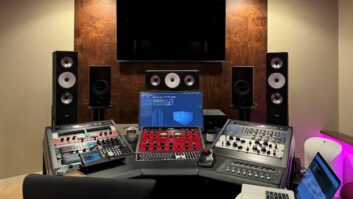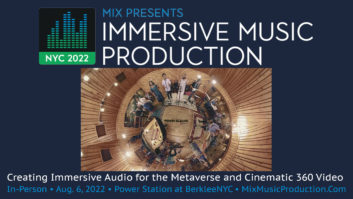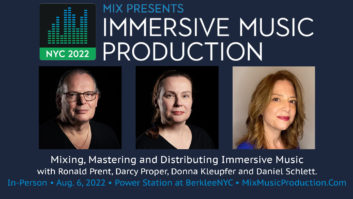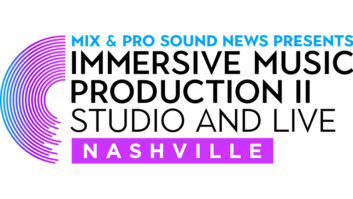
“Hey, I was just making dinner and heard our single in Atmos streaming over an Echo. It sounds weird! What happened to the groove?”
For those of us in the mixing and production world, this is the call you never want from artists. And the artists are not wrong. Usually when any of us is really close to a piece of music and the recording of it, any change is not good and generally not well received at first. Ask any mixing engineer the nightmares of “But I love the rough.”
So much of what happens to mixes after we let go of them is out of our control. It is scary enough when your work is judged through a strange phone, the latest earbuds, a million-dollar super-hyped home system, a brand-new whiz-bang car, any number of audio “enhancers” people install (or inadvertently have). Now, your favorite recordings suddenly appear on a streaming service, branded in a new format, with little apparent regard to pursuit of the original production values, no obvious credit to the engineers and mixers who gave months of time to the music. All attention is spent on the “new delivery” rather than the art itself. It is terrifying.
In the immersive, surround, spatial, virtual, 3D, 360, Atmos, whatever you want to call it world of playback, the chances of severe change are huge. And when it comes, out goes the groove you work so hard to keep. We struggle to get the melody up there, the cool sounds, the trippy effects, the escape we give the listener, and at the root of it all is the groove. Usually when a spatial enhancer, a room simulator or some new algorithm to make the sound “better” touches it, well, most times, in my experience, I get that call discussed above. “What happened to the groove?”
One of the best things I ever did for my creative life was a byproduct of necessity: I got rid of all the old gear I had been carting from room to room for 30-odd years and started making recordings with no old habits. I had to start from creative scratch and go from there. I learned a lot, and remembered quite a bit that I had forgotten or taken for granted.
The same freedom is in front of us today. There is no right or wrong way to approach mixing in a spatial format. We have to figure it out for ourselves and see what sticks. As with any introduction of a new format, the opportunities for a new experience are motivating, but the job remains the same: Do the music justice in all the ways people will hear it.
I feel the important thing is to not settle. Just because you can have the guitar fly over your head like the helicopter in the police chase of the latest Atmos movie does not mean you should. As music mixers, we have a responsibility to the groove. The writers, the players, the artists, the labels—everyone depends and counts on us knowing how to keep it, how to get it to translate, and how to play it back loud and cool, just like they last heard it. They don’t want to know about the battle of codecs and the glitch in the algorithm from the renderer to the upload to the satellite to the download to the player to the $200 coffee can smart speaker in the corner of the kitchen with five dinky speakers built in it.
The first stereo records were an afterthought and a deliverable created on the weekend by assistants spreading out the mono mix. When that became a real thing and accepted, then the stereo records became amazing. The old school learned from the new school, shared ideas, and iconic recordings were created all over. I feel this happened in quad, surround, 5.1, 7.1, theater, et cetera. Which brings us to Atmos/360. It is not just a brand/nametag. It is a completely new paradigm based on one that has been budding for over 40 years.
Why is “immersive” here anyway? Well, first, music needs to be sold to continue being made, and labels need to keep selling their now-huge catalogs of archived music as well as new music to keep us recording pros recording.
It is really fun to hear something you love—or discover something new and fall in love with it—in an exciting format that delivers. Sometimes that can be as easy as headphones and a walk through the city, your senses consumed in a stereo mix of your favorite music against the changing landscape. Sometimes that new format can be a car with a surround system that really works; you are suddenly driving your own spaceship through life, consumed in sound.
The METAlliance Report: METAlliance on Lockdown
The METAlliance Report: Grid Versus Groove
The METAlliance Report: How to Choose Your Next Studio Monitors
The latest way to deliver what we do is to stream it. Bit rates are getting higher, playback devices more powerful, headphones and earbuds and speaker systems are getting better all the time. The convenience and size of the music library you can accumulate are phenomenal. And our employers can charge a premium for the hi-res stuff. But that is not enough, and also not all there is.
What to do? I started by asking everyone I could find who is mixing in immersive formats, “Just what is it?” I got an amazing selection of technical definitions. I won’t even try to give you one. What I can tell you is that the tools we have now promise to put sound around you, not just in front of you, and they do it with not one or two speakers but a whole bunch of them, along with a ton of metadata. The people who build these tools have licensed lots of processing and algorithms into devices to ensure, as much as possible, that playback sounds appear where you heard them in your mix space. Right.
So you mix in your favorite control room. Then you “render the mix” in a particular release format. That finished experience goes to a home, or another studio, or a theater, or a car or a set of binaural headphones, and the software in that device looks at the metadata with your music and then shifts all the individual sounds to fit what it thinks you meant.
My experience? Everything I did at first wound up being a horrid ball of phase somewhere in the room, and both the artist and my best friend stared at me like I’d lost my mind. I could not hit stop fast enough.
There are two things I think we need to do.
The first: We have to practice. We have to woodshed with these new tools like the first day we recorded anything and tried to get it to sound better. Maybe I am slow and not too bright. It took me 20 titles of different music, experimenting in headphones and my surround room, taking notes and then driving to my friends’ places and playing back on their systems—and it sucking—before I got one mix that held up well in all the places I could play it. That’s a lot of hours. It is homework. And I admit that I got discouraged.
Some of my heroes mix hits all day long and twice on Sundays, then break the mix out in surround and print that as well. Scary good. With the younger cats who are mixing the newest music, producing for Atmos and 360, the experience in headphones and rooms is incredible. Different. New. But you know what? It took them practice to get that good.
I ask them, how did you do this or that? I asked the Dolby and the Sony cats, how do I do this? I found that everyone I asked really loved music and was into helping, and had developer kits or projects ready for me to try. Go online and reach out. The better we get, the better the experience gets, the more it’s affordable, the more it sells, the easier the powers that be can go forward. And if they go forward, we work!
The second important thing: We have to stand up for our credits and our compensation. Please—it is an insult to the art of mixing, recording and music itself to rush to market with new branding without respectful regard for creative benchmarks, quality control and the teams who brought the music to life in the first place. We have to be allowed to create “great”—not just “good enough.” A shortsighted bottom line in production cost will destroy the chance of a legacy for these new immersive formats just because we aren’t given the time or tools to finish properly.
At this point, it is important to say that those tasked with the job of selling are family, too, and we must remember it. They should not be stripped of their love of the music and forced to lose sight of the art. Their bosses need to be reminded that just attaching a label and a new playback medium to something loved does not mean that fans will still love it and pay more for it.
If I miss the mark creating a new version, I do the worst offense there is: I lose the art, and incur the wrath of loyal fans. Trust me, I know. I was lucky; I did some forensic mixing with archived tracks to learn what the (brilliant) mixers and production teams had done to try and re-create it for something yet unreleased and new—and when I missed, it was not well received. My inbox lit up, my heart sank to the floor, and I asked, “What was the point?”
Like mono to stereo to quad to 5.1 to 7.1 to VR to binaural to immersive, whatever, we need to learn how a piece of music will best be heard in any and all circumstances. The studying, care and attention to the experience require three things: learning, time and talent. I ask you allow yourself to make room for all three.
I have two favorite quotes that fit my feelings about all this. The first is from singer Steven Tyler, who said, “Dare to suck.” The second is from the sage producer David Briggs, who said, “Be great or be gone.”
METAlliance • www.metalliance.com







